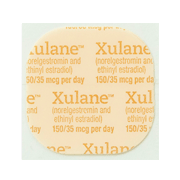
Ortho Evra® Patch
You might like the patch if remembering to take a pill at the same time every day sounds tough.
The patch is a combined hormonal method (synthetic estrogen and progestin). A new patch is placed on the woman’s skin three weeks in a row. It is not used the fourth week during a woman’s period.
We can provide up to a three-month supply of the patch at a visit.
How the Patch Works
- A thin patch is placed on the skin that releases hormones that prevent pregnancy.
- Stops egg from leaving the ovary.
- Changes uterus lining so that a fertilized egg may not implant.
- Prevents sperm from reaching the egg
Advantages
- No need to do or remember anything every day.
- No need to interrupt sex.
- Easy to use and very effective.
- It is ok to bathe, swim, exercise, and be where it is humid while wearing the patch.
- May improve acne.
How the Patch is Used
- See your health care provider for a prescription.
- Be careful not to damage the patch when you remove it from the package.
- If you apply the patch within the first 24 hours of your period, no back-up method is needed.
- If you apply the patch on a Sunday after the first 24 hours of your period, use a back-up method of birth control for the first seven days after you start using the patch.
- Clean and dry an area of skin on your buttocks, stomach, back or upper outer arm where you will place the patch. Apply each new patch to a different place on your skin. Never apply the patch to your breasts or to skin that is red, irritated, or cut.
- Do not apply the patch on top of make-up, lotions, creams, powders, or anything else but clean skin.
- Press firmly on the patch with the palm of your hand for 10 seconds and run your fingers around the edge of the patch to make sure the edges stick well. Check your patch every day to make sure all the edges are sticking.
- Wear the patch for seven days. On the eighth day, take off the patch and put on a new one.
- Do not decorate or write on the patch; doing so may damage it so that it will not work as well.
- When removing the old patch, fold it in half so that the medicine side is covered up before you throw it away. Do not flush it down the toilet.
- Apply a new patch once a week for three weeks, and then do not wear a patch on the fourth week.
- Begin your next four week cycle by applying a new patch on your normal ‘patch change day’, no matter when your period begins or ends.
- If your patch comes loose or falls off for less than one day, try to re-apply it or apply new patch immediately. No back up method is needed.
- If you forget to change your patch during the first week or if your patch comes loose or falls off for more than one day, or if you aren’t sure how long, put on new patch immediately. This will begin a new week. Use a back-up method of birth control for seven days
- Do not try to reapply a patch if it’s no longer sticky or if it has been stuck to something besides your skin
- Store the patch in its package, at room temperature, until you are ready to use it.
- If you are scheduled for any lab tests or need to take other medicine, let your health care provider know you use the patch. Be aware that your patch may interact with over-the-counter or alternative medicines.
- Call your health care provider right away if you miss your period or if you have pain in the chest, calf, stomach, or head; shortness of breath, vomiting, dizziness, coughing of blood, problems with vision or speech, breast lumps, yellowing of the skin or whites of the eyes, or depression.
Possible Problems or Disadvantages
- There may be a higher risk of side effects, such as blood clots with the patch.
- Does not protect against STIs or HIV/AIDS.
- May not work well on women who weigh more than 198 pounds.
- Skin under the patch may get irritated.
- May have irregular vaginal bleeding or spotting. This may stop after a few months.
- If the bleeding lasts more than a few days or happens every month, contact your health care provider
- Contact your health care provider if your fingers or ankles start swelling or if you start having problems wearing your contact lenses.
- Skin on the face may darken.
- The patch should not be used while breast feeding.
- May not be able to use the patch, depending on your health history.
- The most common side effects include nausea, mood changes, headache, breast tenderness, and skin irritation where the patch is worn. Less common side effects include: menstrual cramps, appetite changes, loss of scalp hair, rash, vaginal infections, and dizziness.
- Serious side effects will be more likely to happen if you smoke; these include: blood clots, heart attacks, strokes, and breast cancer. Other serious side effects include gall bladder disease, and liver tumors.
How Well Does it Prevent Pregnancy?
- With typical use, 8 out of 100 women might get pregnant in a year while using the patch.